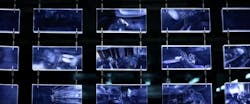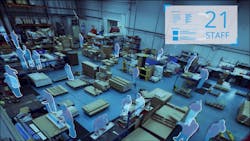Radar applications: The Dark Knight vs. the real-world
One of my very favorite films is 2008’s The Dark Knight—which is probably Christopher Nolan’s best work as a director, and features Heath Ledger’s posthumous Oscar-winning performance as The Joker.
One of the subplots of the movie is how Bruce Wayne makes use of modified cellphones to triangulate a signal as a means of finding The Joker through surveillance. The audience is to assume that Batman hacks all the cellphones in Gotham City to turn each one into a high-frequency generator/receiver and microphone. Doing so gives him a detailed visual and audio map of the city and everything happening in it in real-time. Here’s the critical scene where the technology is explained:
Now, a simple YouTube search informs me that—to no surprise—what Batman did is very implausible, though not impossible. In order for it to work, he’d have to install a new piece of hardware on every cellphone being used in this project, which would take forever given that Wayne’s research & development head (Morgan Freeman) says there are 30 million residents in Gotham. Along with that, a myriad of mapping shortcomings and other quality issues would make the feat unrealistic to achieve. But, it’s a movie and I can suspend those technicalities.
Nevertheless, I couldn’t help think about The Dark Knight while taking in a keynote presentation this past Wednesday at EDI CON USA in Santa Clara, CA on the topic of Radar. Ovi Jacob, director of business development at Vayyar Imaging, delivered a keynote called “Looking Deeper: Using Radar to Save Lives and Improve the World,” which, unlike a movie, delivered how radar is actually being used to help people right now.
Jacob explained how Tel Avid-based Vayyar is using radar as a new modality for breast cancer screening. The company’s initial application was to create a chip that is able to send commands to antennas to transmit and receive waves inside the human body. In the case of breast cancer screening, a Vayyar sensor is able to provide real-time 3D imaging, differentiating between normal fatty tissue and cancerous growth within 60 seconds. Jacob noted how a mammogram machine typically costs $200,000 to $400,000, is large, ionizing, is painful for the patient, and provides only 2D images. Meanwhile, Vayyar’s 3D imaging sensor is non-ionizing, non-painful, mobile, and costs less than $5,000. Jacob said it will still be a while before Vayyar receives FDA approvals for the sensor, but the company is hoping to roll out usage in 2019.
Meanwhile, another Vayyar radar concept is already commercially available, and it’s similar to Batman’s sonar project. Vayyar’s Walabot 3D programmable sensor has numerous applications, including:
- At-home person tracking for fall detection and posture. For elderly people who wear a voice-over-Internet-protocol (VOIP) device, they often don’t wear it to bed or in the shower—two of the most common areas for falls. The Walabot eliminates the need for a wearable in the home. Walabot Home includes a VOIP call alert mechanism.
- Do-it-yourself jobs that require seeing what’s behind a wall. Walabot DIY can see in-wall piping, wiring, rodents, and more by using a PCB with antennae that connects to a smartphone via an app.
- Measuring water density in the ground, critical for farming and other irrigation matters
- Milk analysis. Vayyar’s sensors are currently being used to determine FDA/CE approval levels for protein and lactose levels in milk, by running milk through a small tube with an antenna next to it.
- Automotive in-vehicle tracking. Vayyar’s sensors can track people inside a vehicle for whether or not they are wearing a seatbelt and can send them a reminder to do so. It can track if an infant was left in a locked car, or a passenger’s status after an accident by monitoring their breathing/activity level. Airbag optimization can also be monitored.
- Automotive exterior tracking. Vayyar’s sensors can provide 360-degree blind-spot detection for lane-switching, and offer parking assistance.
- Retail: Vayyar’s radar technology can collect data on customers and products in a safe and private manner, giving users capabilities for smart shelves, queue monitoring, door counting, and touchless sizing.
And there are numerous other uses. Though Vayyar’s ‘Power to the People’ competition, makers even found 3D imaging applications for things like tracking gestures while air guitaring, and finding the optimal angle to mount a TV stand at. Get a video overview of Vayyar’s 3D imaging basics here:
Ethics
As far as the ethical issues raised in that clip from The Dark Knight when it comes to spying on people, 3D sensors such as Vayyar’s can be popular alternatives to video-based security cameras or nanny cams. These sensors would provide information about the number of people located in a given room and their positions, but nothing about whom. This makes using radar in this manner especially appealing for institutions like hospitals, senior communities, and hotels, where both privacy and security are of utmost importance.
About the Author



